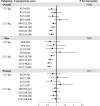Birth weight modifies the relation between adulthood levels of insulin-like growth factor-1 and type 2 diabetes: a prospective cohort study
- PMID: 33648986
- PMCID: PMC7925240
- DOI: 10.1136/bmjdrc-2020-001885
Birth weight modifies the relation between adulthood levels of insulin-like growth factor-1 and type 2 diabetes: a prospective cohort study
Abstract
Introduction: Insulin-like growth factor-1 (IGF-1) has been implicated in fetal and early-life growth and development of type 2 diabetes (T2D). We aimed to examine the interaction between circulating IGF-1 and birth weight in relation to risk of T2D.
Research design and methods: We included 181 090 adults, aged 39-70 years in the UK Biobank Study, who were free of diabetes or major cardiovascular diseases at baseline. Serum IGF-1 levels were determined using chemiluminescent immunoassay method. Birth weight was self-reported; a Genetic Risk Score (GRS) was calculated to define the genetically determined birth weight. The outcome was the incidence of T2D.
Results: We identified 3299 incident T2D cases over an average of 9.9 years of follow-up. Among the participants with birth weight of ≥2.5 kg, IGF-1 levels were inversely associated with T2D risk in a dose-dependent manner (p-trend<0.001). In contrast, the association was not significant among those with birth weight of <2.5 kg (p-interaction=0.001). The GRS of birth weight did not interact with IGF-1 levels on T2D risk.
Conclusions: Our results indicate that birth weight significantly modifies the relation between adulthood levels of circulating IGF-1 and the risk of T2D. Our findings highlight the importance of early-life risk factors in the development of the lifecourse prevention strategies targeting IGF-1 and T2D.
Keywords: birth weight; epidemiology; gene–environment Interaction; type 2 diabetes mellitus.
© Author(s) (or their employer(s)) 2021. Re-use permitted under CC BY-NC. No commercial re-use. See rights and permissions. Published by BMJ.
Conflict of interest statement
Competing interests: None declared.
Figures


Similar articles
-
Lifestyle factors and fetal and childhood origins of type 2 diabetes: a prospective study of Chinese and European adults.Am J Clin Nutr. 2022 Mar 4;115(3):749-758. doi: 10.1093/ajcn/nqab359. Am J Clin Nutr. 2022. PMID: 34698828
-
Serum insulin-like growth factor (IGF)-I and IGF-binding protein-1 in elderly people: relationships with cardiovascular risk factors, body composition, size at birth, and childhood growth.J Clin Endocrinol Metab. 2003 Mar;88(3):1059-65. doi: 10.1210/jc.2002-021380. J Clin Endocrinol Metab. 2003. PMID: 12629086
-
Inverse changes in fetal insulin-like growth factor (IGF)-1 and IGF binding protein-1 in association with higher birth weight in maternal diabetes.Clin Endocrinol (Oxf). 2007 Mar;66(3):322-8. doi: 10.1111/j.1365-2265.2006.02719.x. Clin Endocrinol (Oxf). 2007. PMID: 17302863
-
Insulin-like growth factor I and impaired glucose tolerance.Horm Res. 2004;62 Suppl 1:101-7. doi: 10.1159/000080767. Horm Res. 2004. PMID: 15761241 Review.
-
The role of IGF-I in the development of cardiovascular disease in type 2 diabetes mellitus: is prevention possible?Eur J Endocrinol. 2002 Apr;146(4):467-77. doi: 10.1530/eje.0.1460467. Eur J Endocrinol. 2002. PMID: 11916613 Review.
Cited by
-
Association of childhood-adulthood body size trajectories with risk of micro- and macrovascular complications among individuals with type 2 diabetes: a prospective study.Diabetol Metab Syndr. 2024 Nov 29;16(1):289. doi: 10.1186/s13098-024-01499-2. Diabetol Metab Syndr. 2024. PMID: 39609926 Free PMC article.
-
Classification and identification of risk factors for type 2 diabetes.World J Diabetes. 2025 Feb 15;16(2):100371. doi: 10.4239/wjd.v16.i2.100371. World J Diabetes. 2025. PMID: 39959280 Free PMC article. Review.
-
Insulin-like growth factor-1 and insulin-like growth factor binding protein-3 as early predictors of growth, body composition, and neurodevelopment in preterm infants.J Perinatol. 2024 Nov;44(11):1617-1623. doi: 10.1038/s41372-024-01933-3. Epub 2024 Apr 1. J Perinatol. 2024. PMID: 38561392
-
An exploratory study of clinical factors associated with IGF-1 and IGFBP-3 in preterm infants.Pediatr Res. 2024 Jul;96(2):402-408. doi: 10.1038/s41390-023-02970-y. Epub 2024 Jan 8. Pediatr Res. 2024. PMID: 38191823 Free PMC article. Clinical Trial.
References
Publication types
MeSH terms
Substances
Grants and funding
- R01 DK078616/DK/NIDDK NIH HHS/United States
- R01 DK115679/DK/NIDDK NIH HHS/United States
- MC_QA137853/MRC_/Medical Research Council/United Kingdom
- R01 DK091718/DK/NIDDK NIH HHS/United States
- U54 GM104940/GM/NIGMS NIH HHS/United States
- R21 HL126024/HL/NHLBI NIH HHS/United States
- R01 HL034594/HL/NHLBI NIH HHS/United States
- R01 HL071981/HL/NHLBI NIH HHS/United States
- U01 DK078616/DK/NIDDK NIH HHS/United States
- R01 DK100383/DK/NIDDK NIH HHS/United States
- MC_PC_17228/MRC_/Medical Research Council/United Kingdom
- UM1 DK078616/DK/NIDDK NIH HHS/United States
LinkOut - more resources
Full Text Sources
Other Literature Sources
Medical
Miscellaneous
